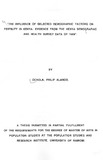| dc.description.abstract | Low ages at first intercourse, first birth and first marriage pose a problem which is highly prevalent in Kenya. This is one of the contributing factors to the persistent high fertility prevailing in Kenya. Ages at first intercourse, first birth and first marriage have an influence on fertility since they affect the length of the fecund period for women. If they are experienced early in a woman's life, then her fertility is bound to be high since she will be exposed to the risk of child bearing for a longer period of time. On the other hand, when they are experienced late, then a woman's fertility is bound to be low since she will have a shorter period of exposure to the risk of child bearing.
The main objective of this study was to examine the influence of selected demographic variables on fertility in Kenya using the Kenya Demographic and Health Survey Data of
1989. The study will confine itselftothe following demographic variables: age at first birth; age at first marriage and age at first intercourse. The study will also confine itself to the following differentials: religion; ethnicity; regions; education and place of residence. Specifically, the study intends to investigate the following objectives:
i). To investigate the variations in mean ages at first marriage, first birth and first intercourse by socio-cultural and socio-economlc differentials in Kenya.
.... ".,~-
ii). To estimate fertility levels in Kenya, using Coale-Trussel P\F Technique, by ages at first intercourse, first birth -and first marriage.
iii). To examine the effect of ages at first marriage, first birth and first intercourse on fertility in Kenya.
iv). To establish the relationship existing between ages at first marriage, first birth and first intercourse and fertility in Kenya.
iv
The Kenya Demographic and Health Survey of 1989 was a national survey which was carried out by the National Council for Population and Development (NCPD) in collabo ration with the Central Bureau of Statistics (CBS) and the Institute for Resource Development (IRD).
Both statistical and Demographic Techniques were used in data analysis. The main statistical techniques used are Mean, Median, Mode (which were derived by cross tabulation technique using acomputer) andthe Multiple Regression Technique. The only Demographic technique used is the Coale-Trussell P/F technique.
The Coale-Trussell P/F technique was used in calculating Total Fertility Rates (TFR) by the various ages at first intercourse, first marriage and first birth. Mean, Median and Mode are summary measures which were used to show the variations in ages at first marriage, first birth and first intercourse by the selected regional, socio-cultural as well as socio-economic differentials. Multiple Regression analysis was used to establish the nature of the relationship existing between ages at first intercourse, first birth and first marriage, on one hand, and fertility on the other hand.
The findings of this study indicate that the m,~n ..a.ges at first intercourse, first birth and
.....
first marriage vary by ethnicity, religion, regions, pla"Cj.£f residence and education.
Specifically, urban places recorded higher means than rural areas. Similarly, those with higher levels of education recorded a higher mean than those with lower levels and no education. Total fertility rates were also found to vary by the various ages at first marriage, first birth and first intercourse. Those who experienced them at early ages recorded higher total fertility rates than those who experienced them at later ages.
The regression results showed that the selected demographic factors (ages at first marriage, first birth and first intercourse) have a significant effect on the fertility index (total children ever born). Generally, the study established that ages at first marriage, first
v
birth and first intercourse are inversely related to fertility (total children ever born). Specifically, age at first marriage was found to have the highest association with fertility. On the other hand, age at first birth was foundto have higher association with fertility, after age at first marriage, while age at first intercourse was found to have low association with fertility.
From the above findings, female education should be encouraged and emphasised at least up to secondary level. This would raise the various ages at first marriage, first intercourse and first birth which would eventually lead to a decline in fertility level. This should, however, be coupled with appropriate incentives where necessary. Similarly, women should be encouraged and assisted to be involved in income generating activities, both in the urban and rural areas. Sex education should also be given freely to the youth. This will assist them in knowing the risks of being involved in irresponsible sex. Contraceptives should also be made available to both the youth and adults. This should, however, be coupled with appropriate contraceptive education on both the merits and demerits ofthe available methods. These are very useful in reducing both adolescent and marital fertility. | en |

